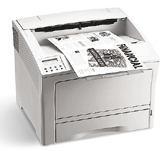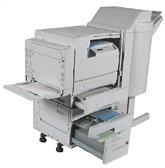Despite great leaps in color laser printing technology over the past few years, it's no surprise that the bulk of day-to-day printing in government offices is done by networked monochrome laser printers. Why spend more than you have to?Color output has gained in speed and quality, but it's still more complex and expensive than black-and-white output. When the content is mostly text and the volume is high, fast monochrome printers are the best tools.These workhorses typically come with robust RISC processors designed to provide duty cycles, or rated workloads, of 100,000 to 200,000 text pages per month and run fast enough to satisfy busy workgroups or small departments.The networkable monochrome lasers in the accompanying chart all have the muscle to run around the clock at speeds of 30 pages per minute or more. Hewlett-Packard Co.'s LaserJet 9000hfn and Kyocera Mita America Inc.'s FS-9500DN are the speediest, at 50 ppm each. More than half the other models run at 45 ppm, which is considerably faster than similarly priced and configured printers a year ago.All the printers offer at least 600- by 600-dot-per-inch true resolution, which is more than adequate for crisp, high-volume page printing.Because of the quality of their components, including their print engines, all the units listed here should perform without trouble for most of their lifecycles, which are far longer than those of low-cost desktop lasers.As for price, many cost less than $5,000. All the machines listed are well below $10,000, with the HP 9000hfn priced the highest at $7,849, and Brother International Corp.'s HL-7050N the lowest at $1,000.Don't feel limited to the models listed. Whenever possible, I selected high-end models from each vendor. If you require fewer bells and whistles, check out a lower-end model in a vendor's series.[IMGCAP(2)]Though there are different laser technologies, all laser printers basically work by charging a photoconductive drum with a laser beam. The laser beam scans across the revolving drum and paints the surface with millions of positive and negative charges that together form the image to be printed.Laser toner, a finely powdered plastic, clings to the charged area of the drum. A fuser assembly melts the toner onto the page. This process results in extremely sharp text images that, unlike ink-jet output, cannot be easily smudged.With current laser technologies, toner can be applied almost as quickly as the printer's transport mechanisms can deliver the finished page.High-speed networked monochrome laser printers are designed to fill the niche between very-high-end document print systems with advanced copying, scanning, collating, stacking and finishing features, and desktop units that do good printing but little else.The objective is a steady flow of copy from dozens of networked users scattered among multiple workgroups and departments. Most models can also be outfitted with enough options to serve capably as small document management systems on their own.With the ability to accept four to six input trays, many can easily handle more than 3,000 sheets of paper. Many monochrome lasers can handle 11- by 17-inch paper, but I was most interested in models handling letter- and legal-size paper.Automatic duplexing is a must. The duplexing feature lets users print on both sides of the paper without manual intervention. It should be built into your printer or available as an option.Systems such as Kyocera Mita's FS-9500DN can have an optional stapler and two- or three-hole puncher, saddle stitcher and bar code reader. Xerox Corp.'s N4525/CN comes standard with a finisher and stacker, while HP and IBM Corp. printers let you add options such as sheet stackers, stapler/stackers, multifunction finishers, scanners and fax accessories.The printers listed are all network-ready, meaning they come equipped with networking hardware'10/100-Mbps Ethernet, token-ring or other network interfaces'along with network management software.These models also have enough RAM expandability to store and move pages of text and images through without a glitch. Almost all come with hard-drive options, which can add extra throughput and storage capability if you want to upgrade your printer without buying a new model.Virtually all support IEEE 1284 parallel ports, which move data bidirectionally over parallel-port cables. All support 10/100Base-T/TX Ethernet connectivity, and many support 480-Mbps Universal Serial Bus 2.0 data rates.Some printers have options for token-ring, RS-232C serial-port connectivity or LocalTalk for Apple networks. You can also find IEEE 802.11b or Bluetooth wireless interfaces.Support for network protocols should include such standbys as Novell NetWare (IPX/SPX), Telnet, EtherTalk, DEC LAT, AppleTalk, TCP/IP, Simple Network Management Protocol and Printer MIB, many of which will be built into the proprietary remote control software.In most cases, these printers come with standard print languages, fonts and typefaces. At a minimum, language support should include HP PCL 6, PCL 5e and Adobe PostScript 2 or 3.Other features of high-end printers such as dimensions, weight, layout and ergonomic considerations are secondary to the functional considerations, but they are likely to become more important if you have to choose from among several models that meet your basic print requirements.Which models do I recommend? Depending on specific requirements, I could be happy with any of the products listed.Brother's HL-7050N runs at a respectable 30 ppm and has RAM expandable to 288M. It has plenty of interfaces and extra input trays as options, which brings its capacity to 2,100 sheets. It is fully networkable and, though it doesn't come with many options, it is a good bargain at $1,000.I have always appreciated Lexmark's straightforward approach to print technology and its varied product lines. The three models listed will all serve you well and are differentiated mainly by speed and various options. Automatic duplexing, 4,100-sheet capacity and MarkVision management software make any of them suitable for the office.
The Xerox Phaser 5400, with a 266-MHz RISC processor, 64M of RAM expandable to 192M and 40-ppm printing speed, is priced at $3,599.
Genicom's $2,989 mL450 has a 250-MHz RISC processor, 64M of RAM expandable to 256M and 45-ppm printing.








